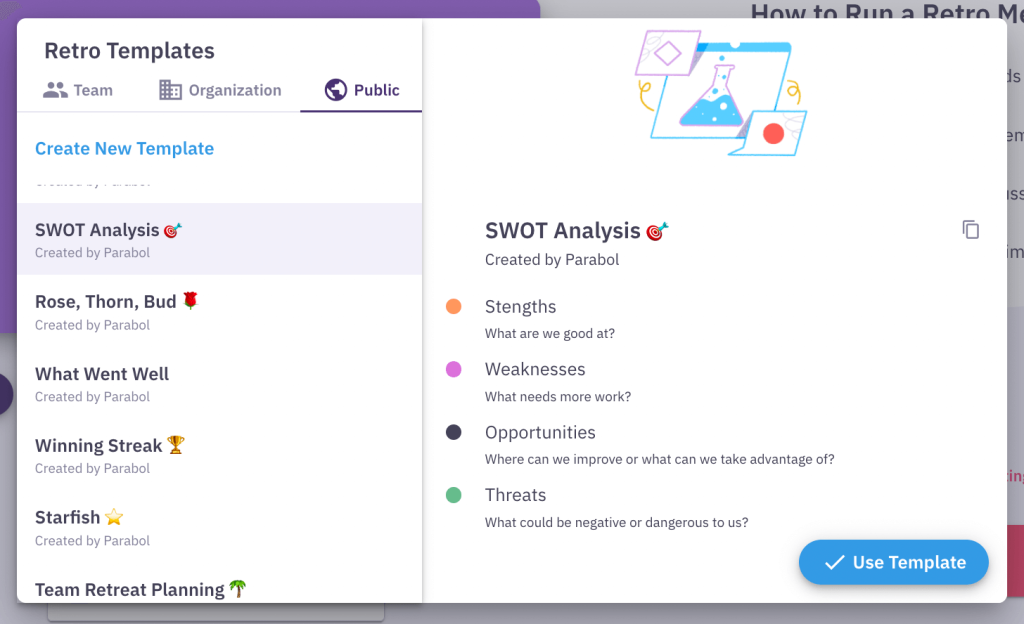SWOT Analysis Template
Examine what makes your team tick with this business-inspired activity

What is a SWOT retrospective?
SWOT stands for Strengths, Weaknesses, Opportunities, and Threats.
Borrowed from the business world, it was designed by Albert Humphrey at Stanford Research Institute as a way to audit a company or organization. But it’s also a useful way to run an agile retrospective, or any kind of in-depth meeting geared towards continuous improvement.
SWOT analysis helps you look inward at your team’s strengths and weaknesses. But it also looks outward, at external factors you’ll need to contend with or take advantage of.
This template uses four prompts – two introspective (strengths and weaknesses), and two that are outwardly-focused (opportunities and threats).
🔎 Strengths and weaknesses
First off, you’ll look at your team. What makes you special, and where could you improve?
These could be your own personal strengths and weaknesses, or ones present in your team as a whole.
Strengths
Where does your team shine? Brainstorm things that you and your team members are good at, and explain how they benefit your team.
Example: I think our scrum master is really good at noticing when people need help. That lets us step in when we have to, and support each other to get to the finish line.
Weaknesses
Weaknesses are unavoidable – noticing and working on them is what matters. Is there anywhere your team’s skills are lacking? Where could you try to improve?
Example: We’re not too comfortable with other programming languages. When we had to work in Python last month, I felt the speed and quality of our work decline.
A facilitator may want to share the responses to these inward-looking prompts before everyone moves on the next two outward-looking ones.
Reflecting on strengths and weaknesses might be useful as your team looks for possible opportunities and threats.
⚖️ Opportunities and threats
Now, it’s time to look outward. What positive and negative events could be on the horizon? How might your strengths and weaknesses prepare you for them, or make them harder?
Opportunities
What opportunities are coming up that your team can take advantage of? This could be ways to work on your weaknesses, or leverage your strengths to work better. After all, weaknesses don’t always have to map to threats, they can also be opportunities for improvement.
Example: There’s a free online Python course coming up. That could be a great way to brush up our skills together.
Threats
Think through any potential obstacles that could negatively impact work, your team, or the company. Could the weaknesses you unpacked earlier make them harder to overcome?
Example: Our scrum master is going on vacation for a couple of weeks. Let’s start planning now to make sure we can work well and solve our own issues without her.
When to do a SWOT retrospective
To kick off or wrap up projects
Because SWOT is all about looking at the big picture, it’s great at the beginning or end of a project. Use it to plan how your team can collaborate better, or identify how things could be done differently next time.
To periodically examine your growth as a team
Try holding a SWOT retro a few times a year, to track how your team has grown and evolved. You might also try it as a team-building exercise after hiring some new team members.
This retrospective format helps agile teams get to know themselves better, and identify areas where they could improve.
To begin or end a year
You can use SWOT to take stock of your competences and figure out your action plan.
For this reason, they’re useful activities for strategic planning when you’re at a crossroads as a team or as a company. SWOT is also a helpful activity at the beginning or end of a year.
How to run a SWOT retrospective in Parabol
First of all, jump into Parabol. If you’re a Scrum Master or the team meeting facilitator hit the vibrant Add New Meeting button.
Select the SWOT retrospective template
Jump into Parabol and select Retro Meeting with the arrows, then use the dropdown to select the SWOT retrospective template. This is where you’ll find Parabol’s library of 40+ retrospective ideas.

Feel free to copy and customize your template as you wish! Maybe you want to add a questions or worries column to your retro to explore some unknowns?
Every Parabol retrospective begins with an optional icebreaker. This box is checked by default. You don’t have to do one, but we recommend it.
Start your SWOT retro with an Icebreaker
If you’re doing an icebreaker, you’ll have a random question to answer. You can refresh it if you want another option, and of course you can create your own if you want.
Perhaps ask team members what they feel their own greatest strength is. Or their biggest personal opportunity over the next months.
After the icebreaker you’ll move on to the reflect stage. This is where your team will do all their ideation and brainstorm in silence using the prompts above. All reflections are kept anonymous at this stage to prevent groupthink.

All Parabol sprint retrospectives can be run synchronously or asynchronously. Functionalities such as the timer, voting and multiplayer grouping help you make your retrospective exercise a success and make facilitation easier.
Reflect, Group, and Discuss topics based on the SWOT prompts
Team members can all leave comments together, or do it at a time that works for them. Also, reflections are anonymous, and no one can see them until you’re done working on them.
After the reflect phase, you’ll vote on issues to discuss, talk about the most voted on items, and set action items for each process improvement so you can make it a reality.
Parabol will send a summary of the retro when you’re done so nobody needs to take notes.
Of course, you can do this retrospective in person, with a whiteboard or sticky notes. But it’s even easier in Parabol, especially if you’re an asynchronous or distributed team.
If you like this template, you might also like our What Went Well meeting!